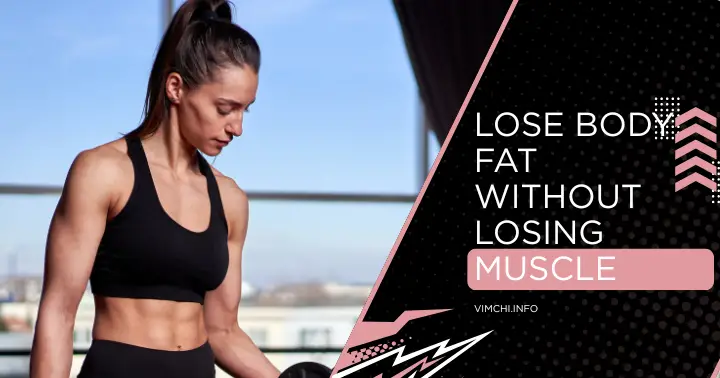
Losing body fat means that you’ll also lose muscle. Preserving muscle mass while losing body fat can be a challenging task. Thankfully, there are ways to prevent losing your hard-earned lean muscle while the fat fades.
But it’s only possible if you follow the right approach.
Why Muscle Preservation Matters?
Muscle is a metabolically active tissue. It not only helps you look toned but it also boosts your resting metabolic rate (RMR), improves strength, and supports long-term fat loss. Losing muscle can slow your metabolism, lead to fatigue, and increase your risk of injury.
Step-by-Step Guide: Lose Fat Without Losing Muscle
1. Maintain a Moderate Calorie Deficit
A small calorie deficit of about 10-20% below maintenance is ideal. This program works because it promotes slow fat loss while keeping muscle breakdown to a minimum.
Tip: Use a TDEE or Total Daily Energy Expenditure calculator to estimate your maintenance calories, then subtract 250-500 kcal daily.
2. Prioritize Protein Intake
High-protein diets preserve lean body mass during weight loss.
- Target: 0.8 to 1.2 grams of protein per pound of body weight.
- Best Sources: Chicken breast, turkey, tofu, Greek yogurt, eggs, protein shakes.
3. Lift Weights Regularly
Strength training sends a strong signal to your body to hold onto muscle.
- Stick to compound movements: squats, deadlifts, bench presses, pull-ups.
- Train 2-4 times per week.
- Focus on progressive overload.
Avoid replacing resistance training with only cardio. It’s a surefire way to burn muscle.

4. Add Low-to-Moderate Intensity Cardio
Cardio does help burn fat. However, balance is always the key.
Best practices:
- 2-3 sessions per week
- Choose low-impact forms, like walking, cycling, and an incline treadmill.
- Avoid long, high-intensity sessions if strength is your goal.
5. Eat Enough Healthy Fats
Don’t go too low on fats. Fats support hormones, especially testosterone, which plays a key role in muscle preservation.
- Focus on: avocados, nuts, olive oil, fatty fish
- Aim for 20-30% of daily calories from fat
6. Prioritize Sleep and Stress Management
Poor sleep and chronic stress lead to elevated cortisol. It increases fat storage and breaks down muscle.
How to optimize:
- Sleep 7-9 hours nightly
- Limit blue light before bed
- Practice stress relief like breathwork, journaling, and walks
7. Track Progress and Adjust
Use multiple indicators:
- Progress photos
- Measurements, like waist, hips, and arms
- Strength levels in workouts
Always remember that the scale alone doesn’t tell the full story. You can’t lose fat and gain muscle at the same time.
Key Mistakes to Avoid
- Overdoing cardio: This can catabolize muscle tissue.
- Under-eating protein: Especially during a cut.
- Crash diets: Fast weight loss often includes muscle loss.
- Skipping strength training: Muscle needs stimulus to stay.
What Should You Eat?
Here’s a sample fat-loss, muscle-preserving meal plan:
For breakfast:
- Egg whites, whole eggs, oats, and berries.
Snack: Greek yogurt, with almonds
Lunch: Grilled chicken, quinoa, steamed broccoli
Snack: Protein shake and banana
Dinner: Salmon, sweet potato, and spinach.
Smart, Sustainable and Strong
Losing body fat doesn’t mean that you have to sacrifice your hard-earned muscle. It’s about being strategic: eat enough protein, train smart, recover fully, and be patient. With consistent effort and small adjustments over time, you’ll lean out while keeping your physique strong and defined.
Always remember that fat loss is temporary. But muscle is an investment.
FAQs
1. How can I lose body fat without losing muscle?
To lose body fat without losing muscle, follow a moderate calorie deficit, eat high protein, strength train regularly, and avoid excessive cardio. Prioritize sleep and stress management for hormone balance.
2. What should I eat to lose fat and maintain muscle?
Focus on high-protein meals, healthy fats, and complex carbs. Include lean meats, whole grains, nuts, vegetables, and adequate hydration. Avoid crash diets and ultra-processed foods.
3. Can I do cardio and still keep muscle?
Yes, if done correctly. Stick to low to moderate-intensity cardio, 2-3 times a week. But avoid replacing strength sessions with cardio. Fuel your workouts with proper nutrition.
4. How much protein do I need to prevent muscle loss?
Consume 0.8 to 1.2 grams of protein per pound of body weight daily. Spread your intake across meals for better absorption and muscle repair.
5. Is it possible to lose fat and gain muscle at the same time?
Yes, especially for beginners or those returning from a break. This is called body recomposition. With the right training and nutrition, you can drop fat while building muscle.
Speak Now ... Or Forever Hold Your Peace